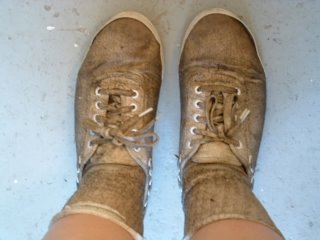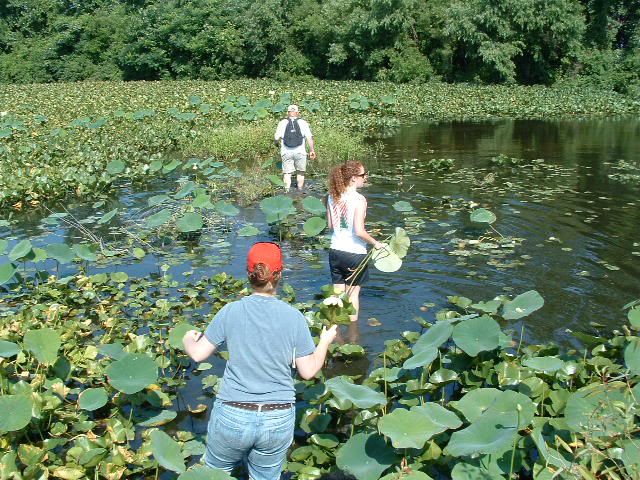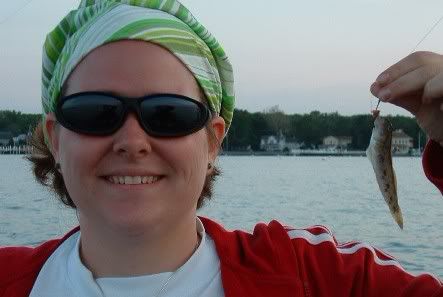There's a party and all the Daphnia are invited
That title there is a quote from
Dr. Doug Kane, who teaches the
Limnology course up here at Stone Lab.
The last two class sessions we've had were just lecture about Grasses, Seges, Rushes and Pondweeds and how to tell them all apart. Since you don't
have to know that and, honestly, it requires a dissecting scope at the least, I'll tell you about something else that happens up here.
So, Dr. Kane started our
lecture series up here for Term 2. Each Thursday evening, you can come sit in on a short talk about what research is going on (that was Dr. Kane) and then you can listen to a guest lecturer (Joan Herbers, Dean of the College of Biological Sciences at OSU).
Dr. Kane's research is focused on
Phytoplankton and
Zooplankton. He's been studying the effects of the nutrient loading, and cleaning by
Zebra/
Quagga Mussels, of Lake Erie on plankton communities.
Why are these important? Because these guys are the base of the food chain. The wee fishies that we love to catch and eat live on phytoplankton for a while and then move up to zooplankton for a little while and
then they move onto their normal menus. Without the plankton, we'd have a serious breakdown of food sources. Hence, Dr. Kane argues, it should be viewed as an
indicator species.
He talked to us about
Limnocalanus macrurus which is a zooplankton that is intolerant to low oxygen levels and high water temperatures. Apparently it was plentiful back in the 1920's but dissappeared for the most part shortly after. It's starting to come back in the
Western Basin of Lake Erie but is being seriosuly predated in the
Eastern and
Central Basins by the Rainbow Smelt.
He's using a process called Planktonic Index Biotic Integrity (P-IBI). And you know, I really have no idea what that means or exactly what it does, but they're using it to find out soom cool things about Plankton in Lake Erie and now they're trying to find out how they can apply this on a global scale.
Our guest lecturer,
Dr. Herbers, who is also a professor for
EEOB, came to talk to us about the dysfunctional families in the insect world. She said that most people think of insect communities, like ants or bees, as the perfect family. Everyone has thier job and they do it and they work together and all is great and wonderful. I guess that's not the case. Workers can get mad at workers, Queens and workers, Queens and Queens, and so on. Dr. Herbers used her research on
Pirate Ants (Arrrr!) to illustrate this.
Picture this: Pirate Ant Queen invades a random host colony, kills off their queen, and starts to lay her eggs. Well, over time, the host colony ants will die off. I guess, the pirate ant offspring are pretty delinquent and can't do anything but raid other host colonies. Why? Well, someone has to do the work because they won't. Once or twice (or more) a season, the queen sends her raiders out and they find a new victim colony. Apparently, these raiders can excrete a hormone that make the victim colony panic so they don't usually fight back. The raiders go in, steal eggs and larvae and take it home with them. These new ants grow up and they have no clue they're not where they are supposed to be. They just go about their business doing what ants are suposed do, work and help their colony survive. As this new group of kidnapped ants die off, lather-rinse-repeat.
In Ohio, it appears we have two different species of pirate ants, one that's been around for a very long time and a new one. Dr. Herbers wanted to see what would happen with the older pirate species and hosts, the newer pirate species and hosts, and what happens when you put both pirate species in the same area with the hosts. Do they kill them off? Does the victim colony survive? How many colonies get invaded in a season?
In order to do thise properly Dr. Herbers and company had to carefully control everything and did so by using ants that are so tiny that they could colonize an acorn. Kinda nice to have your subjects fit into the palm of your hand, eh? They also used DNA fingerprinting so that they could ID which host/victim ants came from which host/victim colony. I won't give away the ending, but it was surprising.
One would think that a talk about ants would be insanely boring but Dr. H managed to make this really interesting and entertaining all at the same time. I give her many props too because about 5 minutes into her almost 2 hour talk, her computer fritzed on her and she had to revert to drawing diagrams on the dry erase board. I hope that I can be that good of a speaker someday. You rock, Dr. Herbers!
FYI: This
lecture series is open to the public. You can either come here to
Stone Lab or you can visit
Ohio State,
Kottman Hall Rm. 333 where it's teleconfrenced.
Let loose the mad-dogs of flora!

After two languid days of swimming, visiting
Put-In-Bay's Christmas in July, and
volleyball (oh, yes, and
studying) we jumped right back into things Monday heading over to
Middle Bass Island.
Backtracking just a smidge, my roommate had been out swimming this past weekend and she found an interesting clump of plants that looked an awful lot like wild onions, but underwater. She brought them in for inspection and Dr. Moore told her to hang on to them. Monday morning, he made a mention of these plants and we all looked at the unsuspecting looking things and headed out. Well, almost as soon as we got off the boat at Middle Bass, Dr. Moore dragged us over to a muddy patch of ground and pointed out the
Flowering-Rush (Butomous Umbellatus). Well, it turns out that this is the same plant as what my roomie saw! Apparently, it has amphibious qualities but is sterile underwater. In other words, it doesn't flower submerged. How cool is that? He then told us about another plant called
Water Star-Grass (Zosterella dubia) that grows long and flaccid in the water but, if on land, it'll grow in a small grassy clump. We have the aquatic "version" of that in our collections already.
We then piled into the van and headed over to Kuehnle Wildlife Area (I had been here before with my
Local Flora class) and we tromped up and down the road for a bit looking at what goodies were in the ditches. We found
Blue-Joint Grass (Calamagrostis canadensis) and
Willow-Herb (Epilobium hirsutum).
Dr. Moore also showed us
Mad-Dog Skullcap (Scutellaria lateriflora) and
Sand Bar Willow (Salix exigua). We even found some awsomely huge
Bulrush (Scirpus atrovirens) which isn't a rush at all, it's a sedge.
After looking at those (and many more) and collecting samples for our
herbariums we headed on down to the other end of Haunks Pond to check out the lilies.

We already got the White Water Lilies on Friday and today's prey was the
American Lotus (Nelumbo lutea). It has these HUGE leaves, easily 12+ inches across on some. Plus, as a nifty educational bonus, they have peltate leaves, meaning the leaves are round with the
stem attached in the middle, on the underside.
Nastutium has them too. Along the way, we had a pleasant surprise in the
Spadderdock (aka Cow Lily or Nuphar lutea). I also got surprised by a large dead
carp, but since I didn't have my camera with me then, I'll spare you.
Needless to say, by the time we got out of there, my shoes were no longer white. (Please see picture above.) I briefly got to see the Bald Eagle that lives there but, per usual, it was not in a good place to take a picture. Perhaps I'll get lucky at Kellys Island this time.
Later that afternoon, once we got back with our
treasures, we learned more about plants in general. We got these great handouts on what the Latin means in the
taxonomy and a
pronunciation guide. Who'd have thought I'd actually be happy to learn Latin?
That evening, after a brief siesta, I decided to take a liesurely row around the island. Of course, I forgot to bring my camera so I missed out on a very pretty sunset and a perfectly perched
Swallow amongst other things. I'll make up for that. My liesurely row ended up not being so liesurely since I decided to make it a collecting trip. Not only was I fishing for weeds but I ended up doing a rowboat obstical course around all the islets around Gibraltar. It was fun and I found some cool stuff.
Today was nice and liesurely too. That's the nice thing about taking one full term class at a time. You get days off to swim (and/or collect plants like we did today), go fishing, check out the sites, or just nap. It's like a vacation where you learn stuff. :)
Nice Najas!
Hello hello! It's time once again to tune into OSU Nature Gal theater! This time, I'll be here at
Gibraltar Island and
Stone Lab for a whole month (or so). My class of choice this time os EEOB 611, Higher Aquatic Plants, aka Aquatic and Wetland Flora. My teacher this time around is
Dr. David Moore of the Department of Biology, Utica College of Syracuse University. (All the pictures I linked to in this entry are thanks to him, by the way, since I forgot to take my camera with us on the first day.)
So, now that the introductions are out of the way,
let's get down to business!
What is different this time than the
last two times? Well, this time, I was kindly allowed to leave most of my belongings here because I knew I'd be back in 4 days. That was a relief and a half. That allowed me to bring up a few more items of clothing and shoes and such because I knew that in this class, we'd be getting soaked on a regular basis. Another thing that is different is that I
brought my car to the island. You can bring your auto over BUT you can't take it back the same day and there's not much parking over here. I left my car over at the free lots on the mainland the last two trips. Of course, I'll be here for 4 1/2 weeks as compared to one.
Day one (Thursday) I got here and immediately went over to
Put-In-Bay to get some lunch (mmmm....fried bologna sandwich and chips!) and do some shopping. I had to get some silly souveniers for Mom, ya know. I even went and got a psychic reading done for fun! I love it when they tell you good stuff. :D
I came back to the island for the information session (even though I'd already been told I didn't
have to come) and met my roommate and classmates. It was a small group overall. The only term courses going on were mine and
Limnology and two people were taking both. There's a nice intamate group of 9 students this time. It won't be long till I know everyone's name. I like that. We immediately clumped at dinner and it's been that way since (all three days so far).
Our evening intro session with Dr. Moore was simple and straight to the point. Dr. Moore has a silly streak that comes out in the forms of puns (hence the title) and boy can he move. He's always on the move! I love it when I get passionate teachers who love what they teach. It makes all the difference in the world.
Fast forward to Friday, our first full class day (Mondays, Wednesdays and Fridays for this class) and we went over terminology (like
Lacustrine and
Palustrine and what he wanted us to have in our collections. He showed us some great books that had me drooling and wishing they were still in print. The ones that are still in print
will be mine! I learned that
Lake Baikal in Russia is the deepest lake in the world holding as much water as all the Great Lakes combined. We also learned the various classification systems used from
Linnaeus's time till now.
After lunch, the plant collecting fun began. We went to the
docks and learned how to use the grappling hook to bring things in. We began to learn what
Najas and
Potomogetons and
Vallisneria looked like. We learned what the difference between free floating plants, rooted submerged, and rooted emerged plants. We checked out the two different
Elodea that live in the bay. We noticed that very small zebra mussels were attached to the plants here and there and Dr. Moore told us that the
mussels usually start out by settling on the plants and then move to the lake bed.
We then climbed into the
rowboats (I rowed first, it's great excercise!) and headed out into the bay to collect more plants. We got lots of
Water Celery (Vallisneria americana) and
Coontail (Ceratophyllum demersum). There were other's but the coolest one was finding
Long-leaf Pondweed which apparently hasn't been seen in the bay since 1941. I'd like to proudly claim that MY boat found that! Woohoo!
We went from there to
Terwilliger's Pond. We had to pull ourselves under the bridge that leads to it because the water was too high for us to sit up in the boat and row. (To give you a reference on how things change over the years up here, here's a picture of Terwilliger's Pond in
October 2001 and now. Here's a link to a site about
seiche that explains the phenomena.) There was so much algea and water plants that sometimes the oar would collect a pile of green stuff and I coudln't lift it out of the water. Not only did we have the coontail and the water celery but we also had a mass amount of
White Water Lilies (Nymphea odorata var. tuberosa) and two types of duckweed,
Lemna minor with all green leaves and two roots and
Spirodella polyrhiza with red undersides on the leaves and many roots. We also found
Blue Flag of the Iris family and some
Button Bush.
We returned from a hot afternoon on the lake to a great dinner of BBQ chicken and corn on the cob (they feed us VERY well) and I went over with a prior class mate from
Local Flora to our teacher's house (Lisa Brohl, not Dr. Moore) to visit and head out to Put-In-Bay for some socializing. Note: if you're relying on the
water taxi to take you back to the island, make sure you leave on time. That way you're not running and thinking of how far the swim is.
Today has been a lovely day of sleeping in, snarling at the weather (it's too windy to fish in the row boats today), and typing on my blogs. Tonight, my fellow classmates and I are heading over to Put-In-Bay to enjoy the
Christmas in July festivities. This time, my camera is coming with me!
A month of getting wet and dirty!

Is coming soon. Keep a look out here for more about my class, Aquatic and Wetland Flora, at
Stone Laboratory.




